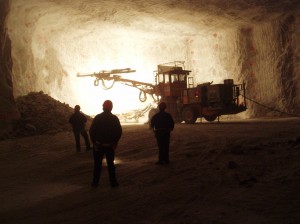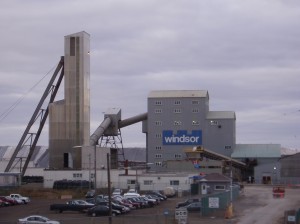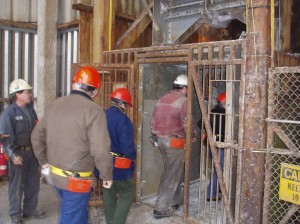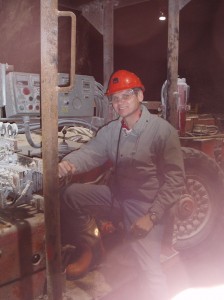 A quarter-mile underground, the spooky floodlit tunnels made me feel like I’d suddenly been transported to the caverns of the futuristic sci-fi film The Matrix. Mines like these, however, came into existence many years in the past, to tap into the valuable seasoning and preservative qualities of sodium chloride, or common table salt.
A quarter-mile underground, the spooky floodlit tunnels made me feel like I’d suddenly been transported to the caverns of the futuristic sci-fi film The Matrix. Mines like these, however, came into existence many years in the past, to tap into the valuable seasoning and preservative qualities of sodium chloride, or common table salt.
Back in the 19th century, Polish health officer Felix Botchkowski observed that salt miners rarely developed lung disease. In 1843 he published a book discussing his findings. Going one better his successor, M. Poljakowski, decided to open a spa that featured salt therapy, which was located in an abandoned salt mine at Wieliczka near Krakow and is still in operation. Its labyrinth of passages, caverns, underground lakes and chapels has drawn millions of visitors since the 1800s.
Salt treatment apparently proved effective for asthma, chronic bronchitis and other respiratory complaints, and salt spas subsequently sprang up all through Eastern Europe. Today, speleotherapy, literally “cave therapy” is still gaining popularity all over the world. You can even bask in an artificial salt grotto right in Toronto!
When treatment specifically features exposure to salt dust or vapors it is more accurately called “halotherapy”. While halotherapy has yet to catch on in a big way in Atlantic Canada, there are plenty of salt mines around, and I decided to check out the one in my home province of Nova Scotia.
Located in Pugwash, Nova Scoti a and operated by the Canadian Salt Company since 1958, this mine features massive caverns extending for miles beneath this small Maritime port.
a and operated by the Canadian Salt Company since 1958, this mine features massive caverns extending for miles beneath this small Maritime port.
My host for the tour works the mechanical end of the salt mining operation. His task can be a gargantuan, as most of the huge machinery used in the mining operation has to be dismantled, brought down a smallish elevator called a “skip” and reassembled 1000 feet underground. Some machine parts even have to be sawed in half to fit down the shaft and then welded back together.
Another long time employee at Canadian Salt helped me get equipped with a helmet, lamp and battery pack and a kit containing a mask that converts carbon monoxide to the much less toxic carbon dioxide.
Now it was time to board the “skip”, or elevator, that would take us a quarter-of-a-mile into the depths of earth.
Our host signalled the operator of the skip using a series of coded buzzes. He then slammed the metal doors shut and we plummeted into darkness. When the skip re-opened we were in another world of yawning caverns — some abandoned and dark, others floodlit and stretching off into the distance. We boarded a modified Toyota Land Cruiser and began a tour which would take in all aspects of the mining operation.
 First stop was the machine shop where all the day to day maintenance needs of the mine’s equipment were cared for. It contained all the gear one would expect in any similar above-ground facility. We stopped here to have a look around and paused to inspect an undercut saw. This looked like some sort of bizarre sawfish-chain saw hybrid with a massive blade used to saw and undercut the bottom portion of a wall of rock salt.
First stop was the machine shop where all the day to day maintenance needs of the mine’s equipment were cared for. It contained all the gear one would expect in any similar above-ground facility. We stopped here to have a look around and paused to inspect an undercut saw. This looked like some sort of bizarre sawfish-chain saw hybrid with a massive blade used to saw and undercut the bottom portion of a wall of rock salt.
Afterwards, we had a look at one of the shelters where workers can stay in case of a fire or other disasters. These contain oxygen, water and necessities to keep occupants alive until rescuers arrive. It is not fire, however, that is the biggest concern in salt mines, but rather water — which can dissolve and undercut salt at a prodigious rate.
Surprisingly, despite the amount of salt around, metal doesn’t seem to corrode quickly in the mine. This may be due to the stable temperatures in the mines.
Hopping back on our Land Cruiser, we drove through a confusing maze of myriads of tunnels. The disused ones were shrouded in black and their openings gaped ominously as we passed.
Periodically we would drive through a serrated plastic barrier designed to guide the air flow from the mine’s ventilation system. It is here that massive turbines resembling the engines of a 747 roar and pump fresh air down into the mine.
Further on we passed interminable lengths of conveyor belts carrying salt to the crusher. Huge insectoid loaders would periodically burst through plastic barriers, looking like beetles intent on some arcane task.
Moving on, we paused again to watch a scaler. The machine allows an operator to guide a giant-sized hooked spike over a wall to remove loose rock. This is a never ending task which keeps miners safe from rock falls. The hook and the process look precisely like those a dentist would use on your teeth. Its action leaves parallel white streaks over the walls and ceilings of all the tunnels.
As I watched the scaler, I happened to glance down and noticed a bright red chunk of salt. Blue-colored salt can also be found, though it is somewhat scarcer. One miner apparently had been trying to find some without much luck until a chunk fell from the ceiling onto his head. The colored salt is considered a nuisance as the goal is to produce a product which is a uniform white in color. It’s felt that the general public might be upset if their table salt came out blue, red or pink.
After we finished watching the scaler, we re-boarded our trusty Land Cruiser and moved on to the crushers, where metal teeth chew chunks of rock salt into a finer grade. This area was hazy with airborne powdered salt, which covered all surfaces and piled like snow drifts across the ground and on fences and equipment.
Fortunately salt is water soluble, so that inspired dust merely dissolves in the lung’s fluids and is transported out of the system by the kidneys. Asbestos, uranium and coal miners are not so lucky. A review of the literature shows that there have been some concerns about diesel fumes in salt mines, though this seems less than problematic at the operation in Pugwash due to its excellent ventilation system.
Some articles suggest that absorption of salt could raise blood pressure in the same manner as consuming too much with food. Other literature apparently refutes this. In terms of carcinogenic potential, Berkeley University studies say that sodium chloride has none whatsoever.
Nowhere did I see any suggestion that salt was toxic to the lungs, but there are many articles touting the health benefits of inhaling salt, mostly of Eastern European origin. Of course saline irrigations of the throat and nasal cavity are standard recommendations by otolaryngologists everywhere who deal with sinusitis and pharyngeal infections.
 Our penultimate stop was at the mine face itself. Twelve-hundred-feet down we found an undercut saw busily chopping away, while next to it a double-barrelled drill burrowed deep into the face of the mine. The drill looks uncannily like the proboscis of a giant mosquito. Here dust was so thick that flash photography showed nothing but a hazy murk.
Our penultimate stop was at the mine face itself. Twelve-hundred-feet down we found an undercut saw busily chopping away, while next to it a double-barrelled drill burrowed deep into the face of the mine. The drill looks uncannily like the proboscis of a giant mosquito. Here dust was so thick that flash photography showed nothing but a hazy murk.
The driver of the drill kindly offered me the opportunity to climb up to the cab and get a perspective on how it felt to be at the helm of his rig. If the drill and undercut saw are unequal to the task, miners drill holes into the walls and insert explosives.
The actual blasting only occurs when the mine has been evacuated of all personnel.
Of course no one could leave the mine without finding a dark tunnel and then shutting out all the lights. We did so, and then one by one extinguished our lamps. The blackness was so complete we literally could not see our hands in front of our faces.
Time perception in the mine seemed somehow altered, but all too quickly it was time to head back to the surface. We headed back to the skip, noticing a significant change in air pressure as we entered the antechamber to our transport. We boarded the skip and shot skyward. Next stop was the chill air of a November evening.
Previously I had pretty much taken for granted the salt that I spread on my walkway, sprinkled (sparingly) on my fries or gargled. Now whenever I use salt I reflect on where it came from and the effort involved in getting it from mine to home.
And who knows? Maybe the Canadian Salt managers will adopt my suggestion to open a spa in Pugwash. If the salt ever runs out the miners could retrain as massage therapists!
Further info…
2. Dead Sea Halotherapy (for those who get claustrophobic underground) or www.jordandeadsea.com
3. Speleotherapy Clinic (above ground therapy for those who don’t want to leave Toronto)
Photo Credits
“At the mine face” © George Burden
“Windsor Salt, above ground” © George Burden
“Boarding the skip to plummet a quarter mile underground” © George Burden
“Author aboard the undercut saw © George Burden


Glad you enjoyed the article, Gil. I always like to get a different angle on things sometimes taken for granted…sort of like: “Who knew?”
Hi George,
Thanks for this fascinating look at something that we all take for granted!
Cheers,
Gil